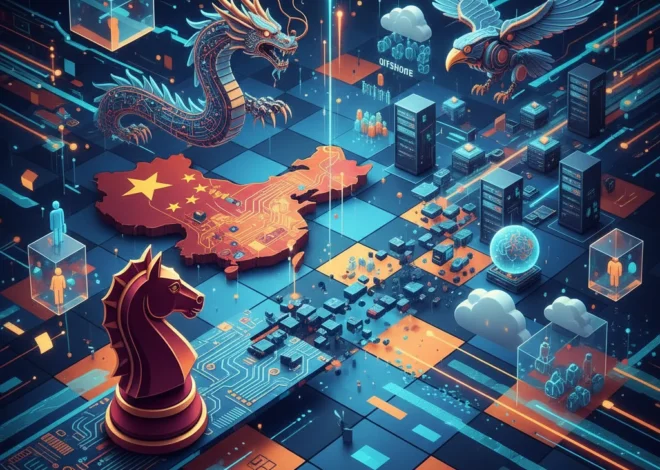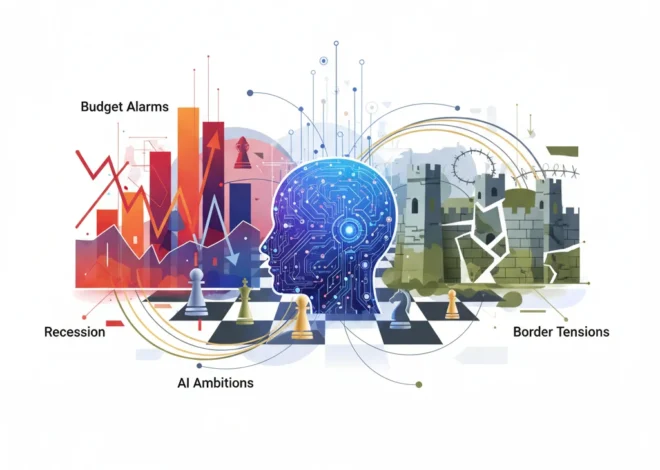
Nvidia vs. Google: Is the AI Chip King’s Throne Truly Safe?
In the high-stakes world of artificial intelligence, a single component reigns supreme: the GPU. And for years, one company has been the undisputed king of that realm: Nvidia. Their technology powers everything from the large language models changing our world to the groundbreaking research happening in labs across the globe. So when a titan like Google steps into the ring with its own custom silicon, the industry watches with bated breath. Recently, Google unveiled its next-generation AI accelerators, prompting a confident, almost dismissive, response from the reigning champion. Nvidia’s stance? They are still “a generation ahead of the industry,” according to a recent statement.
But is this just corporate bravado, or is Nvidia’s moat truly unbreachable? In this deep dive, we’ll unpack the escalating AI chip war, analyze the technology behind the headlines, and explore what this clash of giants means for developers, startups, and the future of innovation itself. This isn’t just a story about hardware; it’s about the software, strategy, and ecosystems that will define the next decade of technology.
The Challenger’s Gambit: Google’s Two-Pronged Attack
Google’s recent announcements weren’t just a minor update; they represented a significant strategic push to control its own AI destiny and offer a compelling alternative to the market. The company unveiled two key pieces of hardware: the Axion CPU and updates to their Tensor Processing Unit (TPU) family.
1. Google Axion: A New Contender in the Data Center
Axion is Google’s first custom Arm-based CPU designed specifically for the data center. While GPUs get most of the AI glory, CPUs are the workhorses that handle a vast array of general-purpose computing tasks. By creating its own CPU, Google aims to improve performance and energy efficiency within its own massive cloud infrastructure. According to Google, Axion delivers up to 30% better performance than the fastest general-purpose Arm-based instances currently available in the cloud (source). This move puts them in direct competition with Intel, AMD, and Amazon’s own custom Graviton processors.
2. The Trillium TPU: Powering the Next Wave of AI
More directly aimed at Nvidia’s core market are Google’s TPUs. These are custom-designed chips (ASICs) built from the ground up for machine learning workloads. The latest generation, dubbed Trillium, is the 6th iteration and promises a massive leap in performance. Google claims that Trillium delivers a 4.7x improvement in compute performance per chip over the previous TPU v5e generation (source). These chips are the engine behind Google’s own AI models like Gemini and are made available to customers through the Google Cloud Platform. The goal is clear: provide a powerful, efficient, and cost-effective alternative to Nvidia’s GPUs for training and running large-scale AI models.
Google’s strategy is about vertical integration. By designing its own silicon, it can optimize the entire stack—from the hardware to the software and cloud services—to work in perfect harmony. This reduces their reliance on third-party vendors like Nvidia, potentially lowers costs for their cloud customers, and gives them a competitive edge in the fierce `cloud` computing market.
The Glass Box Revolution: Why Transparent AI is the Key to Rebuilding Our Trust in Technology
The Champion’s Response: Why Nvidia Isn’t Worried
Faced with this challenge, Nvidia’s response was a masterclass in corporate confidence. The “generation ahead” comment isn’t just talk; it’s backed by a multi-faceted strategy that has, so far, proven incredibly resilient. Nvidia’s dominance rests on two core pillars: relentless hardware innovation and an unparalleled software ecosystem.
Pillar 1: The Unrelenting Pace of Hardware Innovation
Just as competitors start to catch up to Nvidia’s last-generation chips, the company unveils something new that moves the goalposts entirely. Their latest announcement, the Blackwell B200 GPU, is a testament to this. The B200 is, by all accounts, a monster of a chip. Nvidia claims it can offer up to a 30x performance increase for certain AI inference workloads compared to its already-dominant H100 GPU (source). This relentless cycle of `innovation` keeps them at the bleeding edge of performance, making their hardware the default choice for anyone who needs the absolute best.
To put the current landscape into perspective, here is a simplified comparison of the key players in the high-end AI accelerator market:
| Company & Chip | Chip Type | Key Differentiator | Primary Use Case |
|---|---|---|---|
| Nvidia (Blackwell B200) | GPU (General Purpose) | Extreme performance, massive software ecosystem (CUDA) | AI training, inference, high-performance computing |
| Google (Trillium TPU) | ASIC (Specialized) | Optimized for Google’s software stack (TensorFlow, JAX) | Large-scale AI model training and inference on Google Cloud |
| AMD (Instinct MI300X) | GPU (General Purpose) | Competitive performance, open-source software (ROCm) | AI training and inference, direct Nvidia competitor |
| AWS (Trainium/Inferentia) | ASIC (Specialized) | Cost-efficiency and integration with AWS services | AI training and inference exclusively on AWS |
Pillar 2: The Unbeatable Moat Called CUDA
Perhaps more important than the silicon itself is Nvidia’s software platform: CUDA (Compute Unified Device Architecture). For nearly two decades, Nvidia has invested billions in building this `programming` model, which allows developers to harness the immense parallel processing power of its GPUs for a wide range of tasks beyond graphics, especially `machine learning`.
CUDA is now the industry standard. An entire generation of AI researchers, developers, and data scientists have built their careers on it. Major `AI` frameworks like TensorFlow and PyTorch are deeply optimized for CUDA. This creates a powerful lock-in effect. Even if a competitor releases a slightly faster or cheaper chip, the cost, time, and effort required for a company to rewrite its `software` and retrain its teams to move away from the CUDA ecosystem is often prohibitively high. This software moat is Nvidia’s true secret weapon, and it’s something that challengers like Google and AMD are finding incredibly difficult to overcome.
What This “Chip War” Means for You
This battle between tech giants isn’t just an academic exercise; it has real-world implications for everyone in the tech ecosystem.
For Developers and Tech Professionals
The dominance of CUDA means that skills in Nvidia’s ecosystem remain highly valuable. However, the rise of alternatives creates new opportunities. Familiarity with Google Cloud’s TPU architecture or AMD’s open-source ROCm platform can be a key differentiator. The challenge will be navigating a more fragmented hardware landscape and understanding the performance and cost trade-offs of each platform. The era of GPU monoculture is ending, and versatile engineers who can optimize code for different architectures will be in high demand.
For Entrepreneurs and Startups
The high cost of Nvidia GPUs is one of the biggest barriers to entry for AI `startups`. Access to more affordable and competitive alternatives on public clouds like Google Cloud and AWS is a game-changer. It democratizes access to the computational power needed to train and deploy sophisticated AI models, fostering `innovation` and allowing smaller players to compete with established enterprises. This competition could significantly lower the burn rate for `SaaS` companies whose business models rely heavily on AI inference, making new types of `automation` services economically viable.
The Ultimate SaaS: How AI and Code Are Powering the Multi-Billion Dollar Quest to End Aging
The Unseen Front: Cybersecurity Implications
The race for more powerful AI hardware has a direct and profound impact on `cybersecurity`. On one hand, threat actors can leverage this power to develop more sophisticated attacks. AI can be used to craft hyper-realistic phishing emails, generate polymorphic malware that evades detection, and even crack encryption at unprecedented speeds. The same technology that powers ChatGPT can be used for malicious ends.
On the other hand, defenders gain powerful new tools. AI-driven security platforms can analyze billions of data points in real-time to detect anomalies, predict threats before they materialize, and automate incident response. The immense processing power of new chips from Nvidia and Google is essential for training these defensive AI models, creating a perpetual cat-and-mouse game where the most advanced hardware often determines the victor.
India's Tech Renaissance: From Global Back Office to Innovation Powerhouse
The Road Ahead: A New Era of Competition
So, is Nvidia’s throne safe? For now, yes. Their combination of cutting-edge hardware and the deeply entrenched CUDA software ecosystem gives them a formidable advantage that is, as they claim, likely a generation ahead of the competition. However, the landscape is shifting rapidly. The world’s largest tech companies are no longer content to be just customers; they are becoming creators, forging their own silicon to power their ambitions.
Google’s efforts, along with those of Amazon, Microsoft, and AMD, signal the beginning of a new, more diverse era in `artificial intelligence` hardware. This competition will fuel innovation, drive down costs, and ultimately provide more choices for the builders and dreamers creating the next generation of technology. Nvidia may be the king, but the castle is no longer sealed. The chip wars have begun in earnest, and the entire tech world will be transformed by the outcome.


